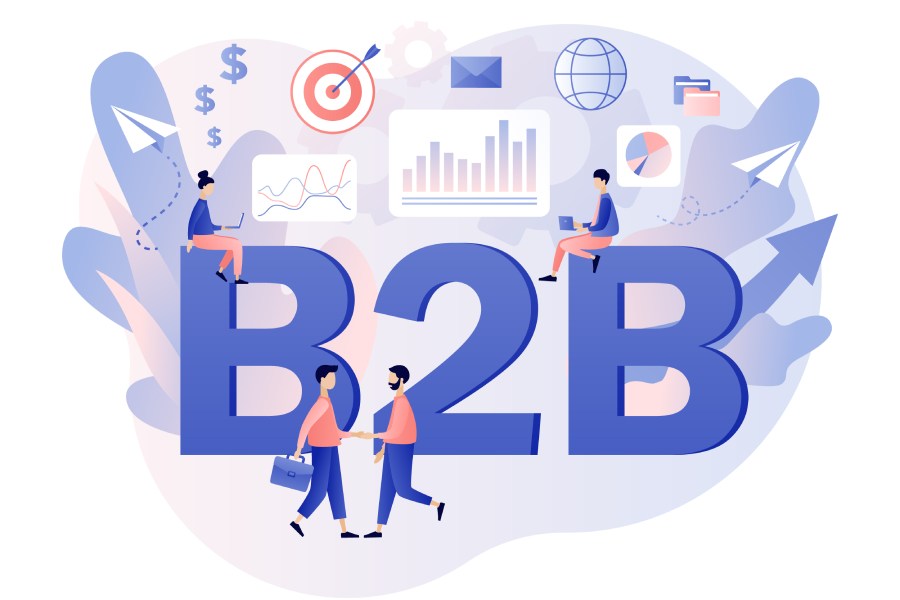B2B Lead Generation Strategies: Effective Techniques for Business Growth
In the ever-evolving world of business, finding new clients can feel like searching for a needle in a haystack. With so many options and strategies available, it’s easy to get lost in the noise. But the truth is, effective B2B lead generation doesn’t have to be overwhelming. It’s all about engaging the right audiences with tailored approaches that resonate with their needs.
By focusing on clear messaging, insightful content, and personal connections, businesses can build strong foundations for growth. Let’s dive into some practical techniques that will not only help you stand out but also attract the clients you’ve been dreaming of.
Effective B2B lead generation strategies include optimizing your website with clear calls-to-action, utilizing targeted paid advertising campaigns, engaging in social media marketing—particularly on platforms like LinkedIn—and implementing content marketing by offering valuable resources such as whitepapers. Additionally, leveraging networking opportunities at industry events and employing tools for personalized outreach can significantly enhance your lead generation efforts.

Top B2B Lead Generation Strategies
Inbound Marketing
When you embrace inbound marketing, you’re harnessing the power of valuable content to pull leads toward your business rather than pushing them away. Think of it as drawing them in with open arms. This approach emphasizes providing resources such as blogs, whitepapers, eBooks, and webinars—all crafted to engage potential clients and showcase your expertise.
It is not merely about selling; it is about sharing knowledge that addresses your audience’s pain points. Research shows that companies focusing on this strategy see conversion rates six times higher than those that do not. The beauty of inbound marketing is that by creating relevant content, you attract leads who are genuinely interested in your offerings, making them much more likely to convert down the line.
With inbound marketing laying a strong foundation, another increasingly popular method is Account-Based Marketing (ABM).
Account-Based Marketing (ABM)
ABM flips the traditional marketing approach on its head by targeting specific high-value accounts instead of casting a wide net. This highly personalized method means that instead of sending generic messages to a crowd, you tailor everything—messages, resources, and outreach—to individual companies.
For instance, imagine a software company designing bespoke demos specifically for each target organization, focusing on their unique challenges and goals. It’s no longer about driving quantity but honing in on quality relationships that yield significant returns.
Gartner reported that 87% of marketers say ABM delivers higher ROI than other marketing tactics, reinforcing the effectiveness of this concentrated method as it fosters deeper connections with potential clients.
As we explore personalization further, let’s discuss how influencer partnerships can amplify your marketing efforts.
Influencer Partnerships
Partnering with industry influencers allows businesses to tap into established networks and gain credibility by association. When a respected figure in your industry endorses your product, it acts as a powerful form of validation that can lead to heightened brand awareness and trust within target markets.
For example, a SaaS company collaborating with a reputed tech blogger can expose their software to an entirely new audience actively seeking solutions. By leveraging these relationships, you not only enhance your visibility but provide influencers with essential content they can share with their followers—creating a win-win scenario.
A study found that influencer marketing can yield an ROI of up to $6.50 for every dollar spent, making this strategy exceptionally lucrative when executed carefully.
While executing these strategies effectively requires support from robust SEO and social media practices, integrating these approaches will position your business favorably for growth in a competitive landscape.
SEO and Social Media Tactics

Optimizing your website isn’t just a one-off task; it requires ongoing effort and finesse. Keyword research is the heartbeat of any successful SEO strategy. It involves digging into what your target audience is actually typing into search engines. Tools like Ahrefs or SEMrush are fantastic for uncovering high-traffic keywords with low competition, ensuring you’re speaking the same language as your potential customers.
Once you’ve established the right keywords, it’s time for on-page optimization. This means tailoring your website’s meta tags, headers, and overall content to include those primary keywords naturally. Think of it as dressing your website in its best attire while ensuring it’s still comfortable enough to engage visitors without sounding forced. When you present information clearly, Google begins to recognize the value you provide.
In addition to these tactics, producing quality content is non-negotiable. Creating valuable, informative articles or resources enables you to address the needs of your audience effectively. Each piece of content should serve a specific purpose—whether that’s educating, entertaining, or addressing pain points—because high-quality content not only aids in attracting organic traffic but also builds trust with your visitors.
Moreover, earning backlinks is crucial for enhancing your domain authority. It’s akin to having endorsements from other reputable sites in your industry. Approach this by cultivating relationships through guest posts or collaborations; over time, quality backlinks will amplify your credibility and propel you higher in search engine results.
Social Media Engagement
While solid SEO practices elevate your search rankings, social media serves as a direct line to your audience.
Leveraging platforms such as LinkedIn and Twitter allows for real-time engagement. For instance, hosting LinkedIn Live sessions covering trendy industry topics or participating in Twitter chats can significantly enhance your visibility and authority. By engaging in discussions that matter to your audience, you position yourself as a thought leader in the field.
Consistent posting schedules help maintain visibility across these channels; however, don’t just post for the sake of it—utilize analytics tools to track engagement rates and reach. This data helps in refining your approach and determining which posts resonate most with your audience. A well-planned social media strategy can work synergistically with SEO efforts, driving qualified leads who are already interested in what you’re offering.
Exploring dynamic interactions and building relationships can further complement these strategies, nurturing connections that lead to lasting opportunities.
Events and Relationship Building

Events and networking have long established themselves as crucial avenues for fostering meaningful connections and building lasting relationships. Whether it’s a bustling trade show or a more intimate gathering, these interactions provide a unique opportunity to create a memorable impression on potential clients.
Picture this: instead of merely exchanging business cards over emails, you’re shaking hands, engaging in real conversations, and showcasing your products up close. This personal touch transforms tedious sales pitches into genuine dialogues, making clients feel more connected to your brand.
Trade Shows and Conferences
Participating in industry-specific trade shows can be instrumental in nurturing leads. At these events, you’re not just a vendor; you’re a participant in the conversation that matters to your field. For instance, consider a cybersecurity firm setting up its booth at a tech conference. Instead of relying solely on brochures or email blasts, they can demonstrate their cutting-edge solutions directly to an audience eager for innovation.
This type of engagement allows them to discuss features and benefits in real time while addressing any questions potential clients may have—taking the experience from mere interest to active engagement.
According to a 2023 Bizzabo report, 85% of B2B marketers believe in-person events are critical for their company’s success. The importance of showcasing your offerings in such interactive environments cannot be overstated; it creates pathways for understanding and trust that simply don’t exist through digital channels alone.
Beyond large events, even smaller gatherings can yield impressive results for relationship-building efforts.
VIP Events and Webinars
Hosting VIP events presents an invaluable chance to cultivate deeper connections with key clients. These exclusive gatherings allow you to tailor the experience to meet the interests and needs of your most valued clients. It can range from a cozy dinner to an immersive experiential event centered around your product offerings.
The key is in personalization; when people feel special and prioritized, they are more likely to build loyalty toward your brand.
Additionally, webinars have emerged as effective platforms for sharing expertise while also engaging with prospects more dynamically. Imagine a financial consulting firm hosting a webinar aimed at guiding executives through economic downturns—this targeted approach not only showcases expertise but also attracts attendees actively seeking solutions during challenging times.
“We’ve successfully converted 30% of our webinar attendees into clients,” says Jane Doe, CMO at ABC Consulting. Her statement echoes the reality that informed sessions raise both awareness and desire among qualified leads.
Engaging directly through various event formats enhances the opportunity to build relationships that last. As we look ahead, we’ll explore how powerful outreach strategies like targeted communications can significantly elevate your lead generation efforts.
Email Marketing Campaigns

Email remains a powerhouse in B2B lead generation. Despite newer platforms, it consistently proves to be one of the most effective channels for connecting with potential clients and nurturing relationships. When executed thoughtfully, email marketing can deliver high engagement and drive conversions essential for business growth.
Personalized Content
One key to ensuring your emails stand out in crowded inboxes is personalizing your content. Tailoring messages specifically to the recipient’s industry, pain points, and interests can significantly enhance engagement levels. For instance, if targeting healthcare providers, consider including case studies or whitepapers relevant to healthcare technology.
This approach demonstrates that you understand their unique challenges and positions you as a helpful resource rather than just another salesperson trying to make a sale.
“Personalization isn’t just a trend—it’s a necessity in today’s marketing landscape.”
By creating content that resonates with your audience, you’re more likely to earn trust, pique interest, and drive them closer to a purchasing decision.
Automated Drip Campaigns
Another essential tactic for maximizing your email strategy involves automated drip campaigns. Platforms like Nureply make it easy to set up these sequences of carefully crafted emails designed to nurture leads over time.
Rather than bombarding potential clients with a sales pitch right away, these campaigns offer valuable insights, education, and resources that gradually guide prospects through the sales funnel. They help build rapport and position your brand as an expert in the field.
Interestingly, data from HubSpot reveals that companies excelling at lead nurturing generate 50% more sales-ready leads while incurring 33% lower costs. Nurturing leads effectively can lead to cost-efficient growth for your business. Automation allows you to engage consistently without overwhelming your team; set up once and let technology do the heavy lifting.
As you refine your email strategies and leverage automation, it’s vital to consider how these efforts align with other digital marketing techniques for maximum impact. Let’s explore how retargeting strategies can enhance your outreach even further.
Retargeting and Online Ads

Retargeting is like sending a gentle reminder to potential leads who have already shown interest in your brand or services. Imagine someone visiting your website, perhaps spending time on the pricing page, but then leaving without making a purchase.
With retargeting ads, you don’t just lose that opportunity. Instead, you can track these visitors using cookies and present them with highly targeted ads as they navigate other sites. This strategic approach keeps your brand top of mind, allowing you to remind visitors of what they might be missing out on.
A compelling example could be offering a limited-time discount on those very products they showed interest in. If they lingered on the pricing page, hitting them with an ad showcasing that offer can evoke urgency and encourage them to act before the deal expires.
Statistics indicate that retargeting can boost ad response rates by up to 400%, as noted by CMO. That’s not merely a number; it’s an indication of how effective this strategy can be in bringing potential customers back into the fold.
Pay-Per-Click (PPC) Ads
Another robust method for generating leads is through Pay-Per-Click (PPC) ads. Platforms like Google Ads and LinkedIn provide businesses the ability to display ads when specific keywords are searched. This ensures that your advertisements reach an audience that is actively seeking solutions you provide, enhancing the chances of conversion. For instance, if someone searches “best CRM software,” they should see your tailored ad right at the top of their search results.
It’s essential to not only invest in PPC campaigns but also actively monitor their performance. Regularly evaluating metrics such as click-through rates and conversion rates allows you to fine-tune your targeting criteria and budget allocation. Over time, you’ll find what resonates most with your audience, maximizing your return on ad spend.
While retargeting and PPC are powerful tools for driving immediate traffic and conversions, this creates a natural segue into exploring strategies focused on direct outreach and personal engagement with potential clients.
Outbound Marketing Techniques

Outbound marketing encompasses various methods aimed at initiating direct contact with potential leads. One of the most recognized methods is cold calling, but there’s more depth to it than simply picking up the phone. Cold calling can surprisingly yield impressive results when approached with thoughtful preparation and specific targeting.
Cold Calling
When executed well, cold calling doesn’t have to feel intrusive. The key lies in doing your homework; thorough research on your prospects allows for a tailored pitch that speaks directly to their specific needs and pain points. By genuinely connecting with a prospect rather than following a script mechanically, you position yourself as a problem-solver rather than just another salesperson.
John Smith, Sales Director at XYZ Corp, shares, “We’ve seen a 20% conversion rate from our cold calling campaigns.” This statistic underscores the effectiveness of personalized outreach.
A well-prepared call highlights how you can solve a prospect’s problem, adding relevancy that resonates with the listener.
Speaking of relevance, let’s dive into another traditional yet effective approach: direct mail.
Direct Mail
Despite the digital age dominating much of marketing today, direct mail remains a potent tool in the outbound arsenal. Imagine receiving a beautifully designed brochure or a personalized letter that piques your interest. This tactile experience can really capture attention in ways that an email often cannot.
For instance, consider a marketing agency sending creative portfolios directly to CMOs of target companies. These portfolios showcase their unique capabilities in addressing pressing marketing challenges and stand out amid digital clutter.
What sets direct mail apart is its ability to create tactile engagement with recipients. When done right—essentially combining creativity with personal touch—direct mail can forge a deeper connection with potential leads than an impersonal email or social media ad ever could.
However, regardless of which outbound strategy you utilize, ongoing assessment is crucial for success.
Monitoring Effectiveness
Outbound strategies should be continuously monitored to gauge their effectiveness and adapt as needed. Regular analysis allows businesses to see what resonates with their audience and which methods fall flat. Are your cold calls resulting in conversions? Is your direct mail leading to inquiries? Leveraging data-driven insights ensures your efforts are not left futile but rather transformed into actionable improvements over time.
In today’s competitive B2B landscape, employing such proactive measures while keeping the focus on personalization can significantly enhance lead generation efforts. This paves the way for improved understanding of campaign performance and optimization strategies necessary for sustained success across different channels.
With these techniques firmly established, we can now turn our attention to how we analyze the impact of our lead generation efforts to continually refine our approach.
Analyzing Lead Generation Performance

Understanding the success of your lead generation efforts isn’t just a matter of gathering numbers; it’s about interpreting those numbers to improve future strategies. Analyzing lead generation performance reveals what works and what doesn’t, helping you streamline processes and make informed decisions. Think of it as a treasure map leading to valuable insights that can drive business growth.
Key Metrics
The first step in this process is identifying important metrics to track. Here are a few key performance indicators (KPIs) that every business should monitor:
- Conversion Rate: This metric reveals the effectiveness of your strategies by showing the percentage of leads that transform into paying customers. For instance, if you generated 100 leads and 5 made a purchase, your conversion rate would be 5%. Monitoring this allows you to spot trends over time.
- Cost Per Lead (CPL): Knowing how much you invest to generate each lead helps in budgeting and forecasting. If your CPL is too high compared to your revenue per customer, adjustments in strategy may be necessary.
- Lead Quality: Not all leads are created equal. Assessing engagement levels and whether leads fit your ideal customer profile can enhance sales efficiency significantly. Engaging with high-quality leads usually results in better sales outcomes.
- Customer Acquisition Cost (CAC): This number includes all costs associated with converting a lead into a customer—everything from marketing expenses to sales commissions. It’s essential to keep customer acquisition costs lower than the lifetime value of a customer (LTV) for sustainable growth.
By closely tracking these key metrics, businesses can uncover meaningful patterns and insights that guide future marketing tactics and investment allocations.
Tools and Techniques
When analyzing these metrics efficiently, utilizing Customer Relationship Management (CRM) systems like Salesforce or HubSpot is highly effective. These platforms provide comprehensive tools for tracking engagement, managing leads, and generating insightful reports—all in real-time.
It’s also important to establish a routine for reviewing these metrics regularly. Whether it’s weekly or monthly check-ins, maintaining consistency will help you quickly identify what’s working well and what may need adjustments or complete overhaul.
In fact, according to Gartner, an impressive 79% of top-performing companies rely on analytics to inform their key decisions. This statistic underscores the increasing importance of data-driven approaches in optimizing lead generation strategies.
The ultimate goal is constant improvement. By fostering an ongoing process of analysis, refinement, and optimization, businesses can maximize their lead generation efforts while significantly enhancing overall performance.







